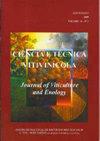葡萄酒的可追溯性和真实性:地理来源、品种和年份评估方法
IF 1.1
4区 农林科学
Q4 FOOD SCIENCE & TECHNOLOGY
引用次数: 4
摘要
这项工作的目的是识别和讨论葡萄酒的物理化学特征,在一定程度上提供与年份,品种和/或地理来源的联系。书目数据集试图为主题理解提供主要信息,确定葡萄酒成分可变性的来源,以及如何用归属类别来表达这些信息。由于葡萄园和葡萄酒所受的所有环境和技术条件很少为人所知,因此对不同的来源进行了检查。由于同位素组成在食品造假检测历史上的重要地位,其研究受到了人们的高度重视。植物基因型与葡萄年份环境条件的相互作用是葡萄酒有机组分和无机组分总含量和相对含量变化的主要原因。这种表现性表达,连同人类和非生物变异源,已经被检查,因为它在一定程度上包含了根据葡萄酒类别进行区分的信息。最近,新的质子核磁共振(1H NMR)光谱技术正在研究中,并同时用于化学计量数据管理程序,显示出根据年份和品种对葡萄酒进行表征的有趣和有前途的工具。本文章由计算机程序翻译,如有差异,请以英文原文为准。
Wine traceability and authenticity: approaches for geographical origin, variety and vintage assessment
The aim of this work is to identify and discuss physicochemical wine characteristics, to provide to some extent a link to the vintage, variety, and/or geographical origin. Bibliographic datasets were attempted to provide the main information for topic comprehension, identifying the sources of wine compositional variability and how these can be expressed in terms of the belonging categories. Since all the environmental and technological conditions which vineyard and wine are subjected are rarely known, different sources were inspected. Great importance was given to the study of isotopic composition because of its importance in food frauds detection history. The interaction of the plant genotype with the environmental conditions of the vintage is the main responsible for the wines organic and inorganic fraction variability in terms of both total and relative content. This phenotypical expression, together with human and abiotic variability sources, has been examined since it contains to some extent the information for the discrimination of wines according to their category. Recently, new proton nuclear magnetic resonance (1H NMR) spectroscopy techniques have been under study and, used concurrently to chemometric data management procedures, showed to be an interesting and promising tool for wine characterization according to both vintage and variety.
求助全文
通过发布文献求助,成功后即可免费获取论文全文。
去求助
来源期刊

Ciencia E Tecnica Vitivinicola
Agricultural and Biological Sciences-Food Science
自引率
12.50%
发文量
5
期刊介绍:
Ciência e Técnica Vitivinícola (Journal of Viticulture and Enology) is an international journal that publishes original articles, research notes and review articles, written in Portuguese or in English, on the various fields of the science and technology of vine and wine: Viticulture, Enology and Vitivinicultural economy.
 求助内容:
求助内容: 应助结果提醒方式:
应助结果提醒方式:


